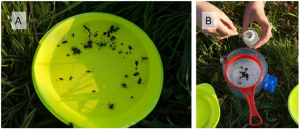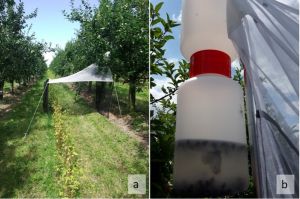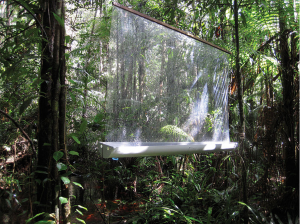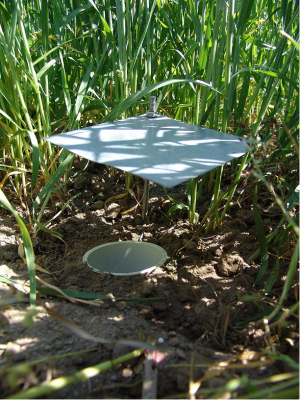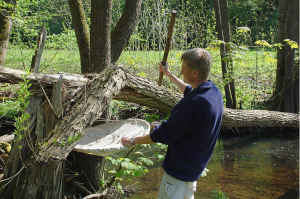Invertebrates
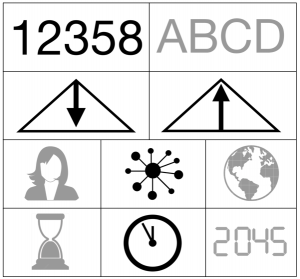
Quantitative - Qualitative
Deductive - Inductive
Individual - System - Global
Past - Present - Future
In short:These methods are applied to catch invertebrates for determining their abundance and/ or diversity.
Contents
Background
Methods for catching invertebrates are systematically applied since the 18th century when René-Antoine Ferchault de Réaumur published the first of six volumes of Mémoires pour servir à l’histoire des insectes (“Memoirs Serving as a History of Insects”) in 1734 and Carolus Linnaeus applied his system of binomial nomenclature to insects (Encyclopaedia Britannica). In the following, different methods for catching arthropods are described and discussed. Since each of the different methods is only suitable for certain taxa, it is necessary to carefully choose the right methods for the taxa that should be analysed (Table 1).
Table 1. Overview which methods are useful for which taxa of invertebrates (according to Sutherland 1996: 140-143).
| Method | Taxa |
| Sweep netting | Invertebrates in low and middle vegetation (e.g. moths, mantises, stick insects, bugs, beetles, adult sawflies, parasitic Hymenoptera) |
| Water traps | Flower visiting insects (e.g. adult flies, adult sawflies, bees and wasps) |
| Flight interception traps | Flying insects (especially active species such as adult beetles, adult flies, adult sawflies, bees and wasps) |
| Pitfall traps/ Barber traps | Active, surface-living invertebrates in low vegetation or on bare ground
(e.g. ground-living beetles, spiders, woodlice, cockroaches and bugs ) |
| Beating | Species living on trees (e.g. spiders, ladybugs, aphids, weevils, mantises, stick insects, butterfly/ moth larvae and larvae of syrphid flies) |
| Emergence traps | Adult insects emerging from their pupae (e.g. flies, mayflies and caddisflies) |
Methods
Sweep netting
In short: Sweep netting is a method that is applied to catch invertebrates in low and middle vegetation.
Background
Sweep-netting is one of the most commonly used methods for catching terrestrial invertebrates. Moreover, it also belongs to the oldest methods of entomology.
What the method does
Sweep netting consists of swinging a sweep net through low and middle vegetation in alternate forehand and backhand strokes at a consistent pace (Sutherland et a. 1996). It is important to select a net with a reinforced rim in round form (Figure 1) or D-form. To standardise sweep netting, usually the same number of sweeps are done in one series of sweeps (Sutherland et a. 1996). The weather should be sunny, dry and not windy to prevent weather influences from having an impact on insect activity (Schuch et al. 2029). The diameter of the sweep net and the number of sweeps have to be defined before starting the sampling (usually between 25 and 200 sweeps) (Ozanne 2005). To catch all the dominant species, at least 200 sweeps should be done in total on one site (Holzinger & Holzinger 2011). A common number is 30 sweeps per series with a length of approximately 1 m. Usually, such a series is repeated a couple of times at other places on the same site. After finishing the series, the closed side of the net is held towards the top to assemble in one place (Sutherland et a. 1996). Afterwards, the net is emptied into a killing bottle, e.g. filled with 70% ethanol. In the bottle, the sample is stored until further identification. For taxonomic sorting and species identification, a binocular microscope is suggested.
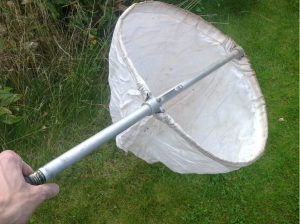
Sweep nets are mostly used during the vegetation period. A standardised design should at least comprise one date of sampling in spring, summer and autumn (Schuch et al. 2020). During the first date of sweep netting, a standardised vegetation analysis should be carried out as many invertebrate species are specific for their host plant.Additionally, a photo documentation of every plot is recommended for each date of sampling (Schuch et al. 2020).
Strengths and challenges
The strengths of sweep netting are that it is quick, low-cost, and efficient (Sutherland et a. 1996). Moreover, it makes it possible to collect a large number of invertebrates and is therefore often used for surveys. It is suitable for catching invertebrates living in the upper and middle vegetation such as phytophagous and predatory grassland species from the taxa Hymenoptera, Diptera, small Coleoptera, Heteroptera, Auchenorrhyncha, Orthoptera and Araneae. This method is rather unsuitable for those species living on the ground and for Lepidoptera (Schuch et al. 2020). Moreover, sweep netting does not work on damp vegetation, vegetation that is either flattened or shorter than 15 cm and high-grown vegetation (Sutherland et a. 1996; Schuch et al. 2020). Another challenge of this method is that it creates a “snap-shot” of the species composition of the site by only covering one point in time. Therefore, it is very important to at least do the sampling on three different dates during the vegetation period. Furthermore, the speed and power of sweeping also influence the number of caught insects. Many flies are avoiding the slow moving net, but are getting caught in a fast moving net (Sutherland et a. 1996). Therefore, the same person should do the sweeping, if different sites should be compared. Differently structured stands of vegetation are another influence on the outcome of sweep netting (Sutherland et a. 1996). For instance, if the vegetation is very flexible, more insects get caught than in inflexible vegetation. However, by sticking to a standardised protocol and selecting plots with a similar vegetation structure, it is possible to achieve representative results (Schuch et al. 2020). Wise and Lamb (1998) have shown that it is possible to reliably track population dynamics of capsid bugs in wheat fields based on a standardised design. Standardised sweep netting allows relating the abundance of invertebrates to the area of the site and can be used in randomised plot designs (see Rösch et al. 2013). It is also suitable for long-term monitoring programs, mostly in combination with other methods such as pitfall traps (Standen 2000).
Water traps
In short: Water traps are bowls in different colours that are filled with water and dish detergent for catching flower visiting insects.
Background:
Water traps are bowls in different colours that play a big role in the research focusing on pollinators. Compared to other kinds of traps, they are relatively cheap and therefore, they are widely applied.
What the method does
Water traps, also called “pan traps”, are used for catching flying insects, especially flower visitors. So far, there is no consensus in the literature regarding which colours are preferred by which group of insects (Moreira et al. 2016). The colour preferences of insects seem to be rather habitat and context-dependent as they are shown to change over time. However, yellow, blue and white have been identified to be the most attractive colours to most species (Table 2).
Table 2. Colour preferences of insect taxa reported by different authors.
| Taxa | Colour | Region | Reference |
| Bees | blue | Brazil | Moreira 2016 |
| Bees except for Andrena limnanthis | yellow | US | Leong & Thorp 1999 |
| Andrena limnanthis females | blue, white | US | Leong & Thorp 1999 |
| Andrena limnanthis males | white | US | Leong & Thorp 1999 |
| Bees, common species | yellow | US | Tepedino 2005 |
| Wasps | yellow | Brazil | Moreira 2016 |
| Hymenoptera | blue and white | US | Campbell & Hanula 2007 |
| Diptera | blue | US | Campbell & Hanula 2007 |
| Syrphidae | blue | US | Campbell & Hanula 2007 |
| Syrphidae | yellow | New Zealand | Laubertie et al. 2006 |
| Coleoptera | white | US | Campbell & Hanula 2007 |
| Hesperiidae (Lepidoptera) | blue | US | Campbell & Hanula 2007 |
Therefore, to assess a pollinator community, a set of pan traps with a combination of these three colours is recommended. By combining these colours, the three most important wavelengths visible to Hymenoptera are covered. This allows the sampling of a broad spectrum of flower-visiting species (Moreira et al. 2016). Water traps can be square or round as the form does not influence the function of the traps. Apart from the colour, the size of the trap is of importance. The larger the trap is, the more insects get caught. Therefore, water traps should at least be 13 cm in diameter. A feasible and inexpensive way of getting water traps in different colours is to buy plastic bowls for parties and paint them in the desired colour with spray paint from a hardware store. Then, the traps are filled with water and a dash of detergent to help break surface tension. To catch a wide range of species, traps should be set at different heights within the survey area. Therefore, it is recommended to put each bowl on top of a platform on a wooden stake that is driven firmly into the ground (Sutherland 1996). To compare catches across sites, the traps should be positioned at the same height to prevent influences on species composition. Total trap catches can be maximised by putting the trap just above the level of surrounding vegetation (Usher 1990).
Ideally, the traps should be positioned in a sunny spot during a period of sunny and warm weather and with little wind. In the evening, the trap should be emptied by sieving the content through a mash and preserving the insects in 70% ethanol (Figure 2). This is to prevent rainwater from leading the trap to overflow so that insects are lost from the sample. Later, the insects are sorted in the lab using a binocular microscope. Depending on the purpose of the study, insects are either sorted into taxa such as Hymenoptera, Lepidoptera, Diptera etc. or distinguished up to genus or species level.
Strengths & challenges
Water traps are a cost-effective way of collecting insect samples as they do not require specialised equipment and can be easily built from cheap materials. Moreover, there is no collector/ observer-effect as there is for methods on which the researcher has a lot of impact such as transect walks and sweep-netting (Leong & Thorp 1999). Additionally, as the traps can be left unattended during the day, a lot of data can be collected for relatively little time and effort. This method is suitable for collecting most flower-visiting insects, especially for bees and syrphid flies. The biggest challenge is that the results are strongly influenced not only by the abundance of insects, but also by their activity. Insect activity declines through low temperatures, high wind speeds and rain. Therefore, water traps should only be set up on sunny warm days with little to no wind. During the day, a trap that was positioned in the sun might be in the shade later on, so the course of sun exposure has to be taken into account as far as possible. So far, a standardised method for setting up the traps is also lacking. Diameters of water traps and time of exposure are strongly varying across studies. The same applies to which colour is suggested to catch which taxa.
Flight interception traps
In short: Flight interception traps are devices for catching flying insects by blocking their flight route.
Background
Flight interception traps are distinguished into Malaise traps (Figure 3) and “windowpane traps” (Figure 4).The Malaise trap was developed by René Malaise, a researcher from Stockholm, in 1937. At that time, sweep-netting was the dominant way to collect insects. Therefore, René Malaise criticised that the way of collecting insects had not changed since the time of Linné (Skvarla et al. 2021). On a field trip, he observed that insects which were caught in a tent gathered at its highest point. This inspired him to use this effect for a new kind of insect trap (Vårdal & Taeger 2011). Until today, the construction of a Malaise trap is reminiscent of a tent with a collecting jar filled with ethanol attached to the highest point where the insects are collected and preserved.
The windowpane trap was developed by Sir Thomas Richard Edmund Southwood in 1978 at the Imperial College London. This type of interception trap was originally based on suspended window frames (Southwood 1978). Since then, several types of window pane traps have been developed based on the original model. However, there is no standardised version of this method so far (Lamarre et al. 2012).
What the method does
The purpose of flight interception traps is to catch insects by blocking them with a fine screen of netting, plastic foil or even Plexiglas®. Blocked insects are then either guided into collecting trays laid beneath the netting (in the case of windowpane traps) or guided upwards into a collecting jar (in the case of Malaise traps). The collecting trays or jars are filled with a preserving fluid. Especially for Malaise traps, 80% to 96% denatured ethanol is used for this purpose. For window pane traps, a mixture of 5 L of water, 150 mL of detergent and 500 g of salt is recommended (Skvarla et al. 2021). Both types of traps are used for analyzing the abundance of individuals of flying insect species. After gathering the insects with this kind of trap, the data is analysed by determining the species and counting the individuals using a binocular microscope. To get representative results, the trap should be placed in a straight angle with the most likely preferred flying routes of insects (e.g. in a straight angle to a flower strip). The time span during which the traps should be set up depends on the purpose of the study. Usually, flight interception traps are set up for time spans between a day and two weeks. The trays under windowpane traps should be emptied once per day to prevent rain water from diluting the preserving fluid. The jar of a Malaise trap only needs to be emptied when it is full as otherwise, the insects do not sink and could be able to fly out of the jar. The samples are transferred to a jar with a lid and later, the insects are sorted in the lab using a binocular microscope. Depending on the purpose of the study, insects are either sorted into taxa such as Hymenoptera, Lepidoptera, Diptera etc. or distinguished up to genus or species level. In cases with a very large number of individuals and little funding, it also makes sense to only weigh the insect biomass (see Hallmann et al. 2017).
Strengths & challenges
Both kinds of flight interception traps are prone to disturbance by passers-by as they are relatively large (Sutherland 1996). Moreover, insect activity strongly influences the results (Matthews & Matthews 1970). Therefore, if possible, the traps should only be set up under weather conditions under which insects are most active such as sunny weather, warm temperatures and little wind. Of course, this is getting more difficult with longer time frames during which the traps should be set up. Windowpane traps are good for catching heavy insects such as Coleoptera and Blattaria, but unsuitable for catching small and active insects (Lamarre et al. 2012). Their size makes them a bit impractical. Moreover, rainwater might dilute the preserving fluid and lead the tray to overflow so that insects are lost from the sample. These kinds of traps can easily be constructed from the researchers themselves. The material costs range between 40 and 90 euros. By contrast, Malaise traps are good for catching small and active insects such as Hymenoptera, Diptera and Hemiptera (Lamarre et al. 2012). For catching most beetles, it is rather unsuitable (Lamarre et al. 2012). Moreover, Malaise traps are quite large, but can be folded like a tent which makes it easier to transport than a windowpane trap. As a benefit, the preserving fluid cannot be diluted as, due to the construction of the Malaise trap, no water can get into the collecting jar. Due to the more complicated construction, it makes sense to buy a standardised Malaise trap from an entomology shop. However, the price for a complete Malaise trap amounts to around 450 euros (bioform 2022).
Pitfall traps/ Barber traps
In short: Setting up pitfall traps is a method to sample active, surface-living invertebrates in low vegetation or on bare ground.
Background
Pitfall traps for catching arthropods were first described by Herbert Spencer Barber at the United States Department of Agriculture in Washington, D.C., in the 1930s. Therefore, this kind of trap is also called “Barber trap”. Pitfall trapping is one of the most commonly used trapping methods for invertebrates, especially for ground dwelling spiders and ground beetles (Carabidae) (Schuch et al. 2020). The traps are straight sided containers with a smooth surface that are dug into the ground with their opening being at ground level (Figure 5). They are installed to catch active invertebrates that live on the ground of the vegetation or on the bare soil (Sutherland 1996).
What the method does
Any kind of container with a smooth surface and straight walls can be used as a pitfall trap. There are no standardised diameters for the containers. However, to make the sampling of a site more representative, it is suggested to use several small containers instead of a big one (Sutherland 1996). A well-suited diameter for pitfall traps is 5 cm to 7 cm (Trautner & Fritze 1999, cited after Schuch et al. 2020;). To prevent the caught invertebrates from eating each other, a preservative solution should be added. A long-lasting solution that does not evaporate is ethylene glycol, “antifreeze” for cars (Sutherland 1996). A trap that is filled with this solution only needs to be checked monthly. However, this solution is harmful to the eyes and skin and therefore, should only be handled with protective gloves and goggles. Ethanol is another preservative solution that is often used in pitfall traps. It has the disadvantage that it evaporates easily, so the trap needs to be checked at least weekly. Hot and windy weather makes it necessary even more often (Sutherland 1996). For emptying the trap, the content is sieved through a muslin. Then, the container is wiped with a cloth to keep the surface smooth. This is especially necessary if slugs and snails have left their mucus. Afterwards, the preservative solution is put back into the trap. If some of the content has already evaporated, more of the preservation solution is added (Sutherland 1996). The species composition caught in the pitfall traps depends on the design and diameter of the container, the preservative solution and a potential cover for preventing small mammals from falling into the trap. To compare trap catches between sites or over time, it is therefore necessary to standardise the traps (Sutherland 1996). Pitfall traps should be positioned in a line or a cross with 2 m to 5 m between two traps. For easier relocation in between the vegetation, they can be marked with a post (Trautner & Fritze 1999; Sutherland 1996). For catching beetles, baits such as cheese, fish and raw meat can be used to make the trap more attractive. The baited traps should not be filled with preservative solutions. Therefore, they need to be checked daily (Sutherland 1996).
Strengths and challenges
Pitfall trapping is a cheap and easy method for catching large numbers of invertebrates. The traps are easy to transport and to install (Schuch 2020; Woodcock 2005). The largest disadvantage is that catch rates vary depending on the surrounding vegetation. The number of individuals that are caught depends not only on the density, but also on the activity of invertebrates. Invertebrate activity, however, is reduced by vegetation in the vicinity of the trap (Greenslade 1964). Moreover, pitfall traps are also known to catch more large invertebrates of more than 3 mm. Additionally, some ground beetle species emit pheromones to attract other beetles of the same species, therefore making the estimate of the population on the site less representative (Sutherland 1996). Pitfall traps are unsuitable for comparing numbers of flying insects such as flies and Hymenoptera, although they also get caught in these traps. For flying insects, the visibility of the trap defines the attractiveness. The visibility declines over time as insects get caught in the trap which then influences the number of caught flying insects (Sutherland 1996). Traps that are marked with a post are more conspicuous to passers-by and grazing stock. This increases the chance of the traps getting destroyed (Sutherland 1996).
Beating
In short: Beating is a technique to collect invertebrates on foliage by sharply tapping a branch with a stick and catching the dislodged invertebrates with a beating tray which is connected to a plastic container.
Background
Beating is a widely used method in research focusing on invertebrates on trees. For instance, in fruit growing research it is used to determine the abundance of vermin and beneficial organisms on fruit trees. This information is used to develop strategies for biological pest control (KOB Bavendorf 2022).
What the method does
First, the beating tray is held under a branch or trunk. Then, the branch or trunk is hit with the stick (Figure 6). The animals that are dislodged from the branch are caught in the beating tray. How many branches are tapped per plant depends on their uniformity (KOB Bavendorf 2022). If the trees are very similar to each other, 33 tapped branches per hectare are often sufficient to achieve a representative result. Otherwise, 100 tapped branches per hectare are recommended. The tapping points should be scattered across the orchard. Only one branch per tree is tapped. Young trees can be tapped on the trunk. The animals caught in the plastic jar are identified visually and counted (KOB Bavendorf 2022).
Strengths & challenges
The strength of this method is that it is a very quick way to collect large numbers of invertebrates. Therefore, it can be used to give an estimate on the number of invertebrates on a number of trees. However, this method is limited to species that are easily dislodged from a branch, but do not fly away when disturbed (Sutherland 1996). Moreover, later in the growing season, when the trees already have fruits, sharply tapping the branches might lead to fruits falling off the branch. To prevent economical loss for the fruit grower, branches with few or no fruits should be selected. In this case, a middle ground between representativity and practical interests needs to be found.
Emergence traps
In short: Emergence traps are containers that are used for catching adult insects such as flies, mayflies and caddisflies emerging from their pupae.
Background
Emergence traps are a measure to assess the number of adult insects emerging from their pupae out of the soil, water or dead wood (Sutherland et al. 1996). This method is used, for instance, in fruit growing research to assess the abundance of vermin, such as the pear sawfly, coming out of the soil. Moreover, it is applied in research programs for assessing the fauna of forests (Winter et al. 1999).
What the method does
The emergence trap is put on top of the substrate that the insects emerge from (Schuch et al. 2020). At its highest point, the container is opened to let the light in and attract the adult insects towards the light (Figure 7). They are caught in a container filled with ethanol. The duration of the trap being set up varies according to the purpose of the study. For analysing the species that are emerging from the soil in a forest, the standard duration is one year (Schuch et al. 2020). The intervals for emptying the trap during this time are dependent on the research question. In fruit growing research, where emergence traps are put up to analyse the emergence of specific pest species from the soil, the time span usually covers the hatching period of the species. Depending on the research question, it could make sense to additionally analyse the soil properties, soil cover (with leaves etc.) and soil composition (Schuch et al. 2020).
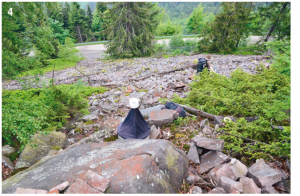
For getting a species inventory of a forest, at least six emergence traps should be placed in a piece of forest. The selected forest stand should be representative for the whole forest, should not have an extremely dense soil and the location of the traps should always be about the same distance from the surrounding trunks (Schuch et al. 2020). Due to its construction, this sort of trap is widely independent from the weather. However, the microclimate in the trap can change due to sun exposure. If a strong sun exposure is to be expected, the trap should be covered in reflective material. This phenomenon is called the “extraction effect” as the emerging invertebrates are extracted from the surrounding soil as they are attracted by the warmth (Schuch et al. 2020).
Strengths & challenges
Emergence traps are well suited for Diptera (Flies and mosquitoes), Coleoptera (beetles), Thysanoptera (thrips), Collembola (springtails) and Araneae (spiders). Only the area on which the sample is taken is standardised, so the volume of the soil is not restricted. Therefore, less active species could be underrepresented (Schuch et al. 2020). Moreover, some species might be attracted towards the trap whereas others are repelled (Sutherland 1996). Therefore, the sample is not completely representative for the species diversity and abundance as there is always a certain bias in using an emergence trap. The first installation of an emergence trap is relatively time consuming as it partly needs to be dug into the ground (Schuch et al. 2020). Emptying the trap is therefore much less time consuming than the first installation. The emergence trap is prone to disturbance by wildlife as the contained ethanol is attractive to animals. Moreover, the danger of the ethanol drying out or overflowing is given due to weather conditions (Schuch et al. 2020). Moreover, emergence traps are relatively expensive with a price of 300 to 400 Euros (Schuch et al. 2020).
Normativity
The decline of pollinator populations in some regions of the world has sparked a lot of interest in the conservation of pollinator species across the world (Baldock 2020, Kleijn et al. 2015, Senapathi et al. 2015). For long-term evaluation of pollinator conservation initiatives, global assessments through standardised methods are required. Potentially, all the methods mentioned in this article have the ability to contribute to this goal. However, so far, most studies based on insect traps were conducted in Northern America and Europe. There are only a few studies for instance from the tropics (Moreira et al. 2016). However, here it is necessary to distinguish between the different tropical regions. For instance, in the journal “Conservation Biology”, the Amazon is mentioned four times as often as the Kongo (Pimm 2007). This example highlights that Africa is even underrepresented among the global south. Although Africa comprises six biodiversity hotspots, it is still underrepresented in international journals on nature conservation and also in studies on insect diversity. Due to the fact that many insect species are protected and some are even on red lists, taking big numbers of insects out of an ecosystem for scientific purposes is often seen as problematic by the public. However, the number of insects that are caught with a trap depends on the time span during which the trap is set up. If it is only set up for a few days, the number of insects caught is negligible. If it is set up for several months, the traps should not be set up at the same location in the following year to allow the insect populations to recover (Hallmann et al. 2017). Moreover, the results could be impacted by the trap that was set up the year before. Also, the largest threats towards insect diversity and abundances are land use change and agricultural intensification (Wagner et al. 2021). The biggest challenge in doing a study based on invertebrates caught by traps is the analysis of the samples as setting up the trap does not take long in most cases and most kinds of traps are efficient in catching lots of insects in a short time without needing to be checked often. Insect sorting, counting and determination, however, is time consuming and therefore expensive. Some species can only be identified by specialists which are rare and expensive. In Germany, a study based on Malaise trap samples became prominent in the media as it has shown a 76% decline in total insect biomass between 1989 and 2016 (Hallmann et al. 2017). The so-called “Krefeld-Study” analysed the catches of Malaise traps that were set up in 63 protected areas including nutrient-poor habitats, nutrient-rich habitats and pioneer/shrub communities. Due to time and financial constraints, only the insect biomass was compared between the different years which led to some criticism from the scientific community. Still, the public impact of this study was very large compared to most scientific studies as the results were internationally reported such as by The New York Times (New York Times 2018). Although insect decline has been observed in other studies as well, the results of studies purely based on malaise trap samples should be interpreted with caution as it is hard to keep all influences stable in the field. In the case of the Krefeld study, the malaise traps were not set up at the same locations. Therefore, the results do not only show the development of insect biomass over time, but also the differences between the locations where the Malaise traps were set up. In general, it makes sense to not base a whole study on only one type of trap. Every type of trap is biased in one or the other way. Therefore, trap types should be combined that complement each other, especially if not only one taxon is analysed and if the species richness and abundance should be related to a certain area.
Outlook
In the future, documenting the insect decline that is observed in some regions of the world might gain even more importance. A large potential to get closer to this goal lies in further standardisation of most of the methods presented in this entry. This is especially true for the methods that rely on traps that can be easily made with low-cost material such as water traps and Barber traps. Standardised diameters and a standardised protocol can make studies more comparable and thus, enable scientists to get a better picture on the global development of invertebrate populations. In the case of emergence traps, sun exposure is one of the biggest sources of bias. To better quantify the impact of sun exposure on the abundance and diversity of emerging invertebrates, the environmental parameters such as sunshine duration, aerial temperature and humidity should in the future be tracked by a data logger inside and outside of the trap (Schuch et al. 2020). The need for standardisation does not only apply to trapping methods, but also to sweep netting. So far, there is no representative big study quantifying the effects of the time of the day and the weather on the outcome. This is a gap that should be addressed by future research. Moreover, standardised sweep netting offers a great potential for comparing insect diversity and abundance of the past to the current situation, as this method has been established for such a long time. Long-term monitoring could be followed up on historic studies, if the samples are still present in archives or museums (Schuch et al. 2020). To make the processing of the samples from trapping or sweep netting more efficient, new methods for faster species determination are being developed based on DNA barcoding. This might make sample analysis faster in the future as the DNA barcode can be compared to a reference library of barcodes of known species origin. However, it might still take some time until the DNA barcodes of enough insect species are collected in such libraries to make this method feasible. Moreover, more studies from less represented regions from the global south are required to quantify how far the trend of insect decline that is reported, e.g. from Europe, is visible in these regions. This is especially important as these regions comprise globally important biodiversity hotspots.
Key publications
Theoretical:
Lamarre, G. P. A., Molto, Q., Fine, P. V. A., & Baraloto, C. (2012). A comparison of two common flight interception traps to survey tropical arthropods. ZooKeys, 216, 43–55. https://doi.org/10.3897/zookeys.216.3332
Skvarla, M. J., Larson, J. L., Fisher, J. R., & Dowling, A. P. G. (2021). A Review of Terrestrial and Canopy Malaise Traps. In Annals of the Entomological Society of America (Vol. 114, Issue 1, pp. 27–47). Entomological Society of America. https://doi.org/10.1093/aesa/saaa044
Empirical:
Hallmann, C. A., Sorg, M., Jongejans, E., Siepel, H., Hofland, N., Schwan, H., Stenmans, W., Müller, A., Sumser, H., Hörren, T., Goulson, D., & de Kroon, H. (2017). More than 75 percent decline over 27 years in total flying insect biomass in protected areas. PLoS ONE, 12(10). https://doi.org/10.1371/journal.pone.0185809
Moreira, E. F., Santos, R. L. da S., Penna, U. L., Angel-Coca, C., de Oliveira, F. F., & Viana, B. F. (2016). Are pan traps colors complementary to sample community of potential pollinator insects? Journal of Insect Conservation, 20(4), 583–596. https://doi.org/10.1007/s10841-016-9890-x
References
(1) Baldock, K. C. (2020). Opportunities and threats for pollinator conservation in global towns and cities./Current opinion in insect science/,/38/, 63-71.
(2) Barber trap. Von Mnolf - Eigenes Werk, photo taken in Kematen, Austria, CC BY-SA 3.0, https://commons.wikimedia.org/w/index.php?curid=2534375
(3) Borges, P. A., & Brown, V. K. (2003). Estimating species richness of arthropods in Azorean pastures: the adequacy of suction sampling and pitfall trapping. Graellsia, 59(2-3)), 7-24.
(4) bioform (2022). Malaise-Falle nach Townes. https://www.bioform.de/shop.php?action=tree&wg=1&pid=706&treeid=5290 (accessed 06/06/2022).
(5) Campbell, J. W., & Hanula, J. L. (2007). Efficiency of Malaise traps and colored pan traps for collecting flower visiting insects from three forested ecosystems. Journal of Insect Conservation, 11(4), 399–408. https://doi.org/10.1007/s10841-006-9055-4
(6) Encyclopaedia Britannica (2022). Entomology. https://www.britannica.com/science/entomology (last access: 22/07/2022)
(7) Greenslade, P. J. M. (1964). Pitfall trapping as a method for studying populations of carabidae. Journal of Animal Ecology 33, 301-310.
(8) Hallmann, C. A., Sorg, M., Jongejans, E., Siepel, H., Hofland, N., Schwan, H., Stenmans, W., Müller, A., Sumser, H., Hörren, T., Goulson, D., & de Kroon, H. (2017). More than 75 percent decline over 27 years in total flying insect biomass in protected areas. PLoS ONE, 12(10). https://doi.org/10.1371/journal.pone.0185809
(9) Holzinger, W. E., & Holzinger, I. (2011). Semiquantitative Kescherfänge zur Zikadenerfassung: Wie viele Kescherschläge sind mindestens erforderlich und welchen Einfluss hat der Faktor „Mensch“ auf das Ergebnis? Cicadina, 12, 107-114.
(10) Kleijn, D., Winfree, R., Bartomeus, I., Carvalheiro, L. G., Henry, M., Isaacs, R., ... & Potts, S. G. (2015). Delivery of crop pollination services is an insufficient argument for wild pollinator conservation./Nature communications/,/6/(1), 7414.
(11) KOB-Bavendorf (2022). Klopfprobe. https://www.kob-bavendorf.de/klopfprobe.html (last access: 21/07/2022)
(12) Lamarre, G. P. A., Molto, Q., Fine, P. V. A., & Baraloto, C. (2012). A comparison of two common flight interception traps to survey tropical arthropods. ZooKeys, 216, 43–55. https://doi.org/10.3897/zookeys.216.3332
(13) Laubertie, E. A., Wratten, S. D., & Sedcole, J. R. (2006). The role of odour and visual cues in the pan-trap catching of hoverflies (Diptera: Syrphidae). Annals of Applied Biology, 148(2), 173–178. https://doi.org/10.1111/j.1744-7348.2006.00046.x
(14) Leong JM, Thorp RW (1999) Colour-coded sampling: the pan trap colour preferences of oligolectic and non oligolectic bees associated with a vernal pool plant. Ecol Entomol 24:329–335
(15) Matthews, R. W., & Matthews, J. R. (1970). Malaise Trap Studies of Flying Insects in a New York Mesic Forest I. Ordinal Composition and Seasonal Abundance. In Source: Journal of the New York Entomological Society (Vol. 78, Issue 1).
(16) Moreira, E. F., Santos, R. L. da S., Penna, U. L., Angel-Coca, C., de Oliveira, F. F., & Viana, B. F. (2016). Are pan traps colors complementary to sample community of potential pollinator insects? Journal of Insect Conservation, 20(4), 583–596. https://doi.org/10.1007/s10841-016-9890-x
(17) Ozanne, C.M.P. (2005). Sampling methods for forest Understory vegetation, In Insect Sampling in Forest Ecosystems. S.R. Leather (Editor). Pages 58-76. Blackwell Publishing, Oxford.
(18) Rösch, V., Tscharntke, T., Scherber, C., & Batary, P. (2013). Landscape composition, connectivity and fragment size drive effects of grassland fragmentation on insect communities. Journal of Applied Ecology, 50(2), 387-394.
(19) Senapathi, D., Biesmeijer, J. C., Breeze, T. D., Kleijn, D., Potts, S. G., & Carvalheiro, L. G. (2015). Pollinator conservation—the difference between managing for pollination services and preserving pollinator diversity./Current opinion in insect science/,/12/, 93-101.
(20) Skvarla, M. J., Larson, J. L., Fisher, J. R., & Dowling, A. P. G. (2021). A Review of Terrestrial and Canopy Malaise Traps. In Annals of the Entomological Society of America (Vol. 114, Issue 1, pp. 27–47). Entomological Society of America. https://doi.org/10.1093/aesa/saaa044
(21) Standen, V. (2000). The adequacy of collecting techniques for estimating species richness of grassland invertebrates. Journal of Applied Ecology, 884-893.
(22) Southwood, T.R.E. (1978). Ecological Methods with Particular Reference to the Study of Insect Populations. Chapman and Hall, Melhuen, London.
(23) Sutherland, W. J., Editor (1996). Ecological Census Techniques - a Handbook. P. 152. Cambridge University Press.
(24) Tepedino, V. J. (2005). Pan-trapping for bees (Hymenoptera: Apiformes) in Utah’s West Desert: the importance of color diversity. https://www.researchgate.net/publication/286779004
(25) The New York Times (2018). The Silence of the Bugs. https://www.nytimes.com/2018/05/26/opinion/sunday/insects-bugs-naturalists-scientists.html (accessed 06/06/2022).
(26) Usher, M. B. (1990). Assessment of conservation values: The use of water traps to assess the arthropod communities of heather moorland. Biological conservation, 53(3), 191-198.
(27) Vårdal, H., & Taeger, A. (2011). The life of René Malaise: from the wild east to a sunken island. Zootaxa, 3127, 38–52. www.mapress.com/zootaxa/Article
(28) Wagner, D. L., Grames, E. M., Forister, M. L., Berenbaum, M. R., & Stopak, D. (2021). Insect decline in the Anthropocene: Death by a thousand cuts. In Proceedings of the National Academy of Sciences of the United States of America (Vol. 118, Issue 2). National Academy of Sciences. https://doi.org/10.1073/PNAS.2023989118
(29) Wiki Commons. Barber trap. https://de.wikipedia.org/wiki/Barber-Falle#/media/Datei:Barber_pitfall_trap.jpg. Photo: Mnolf.
(30) Winter, K. (1999). Programm zur Untersuchung der Fauna in Naturwäldern. IHW-Verlag.
(31) Wise, I. L., & Lamb, R. J. (1998). Sampling plant bugs. Lygus spp.(Heteroptera: Miridae), in canola to make control decisions. The Canadian Entomologist, 130(6), 837-851.
The author of this entry is Anna-Lena Rau.
